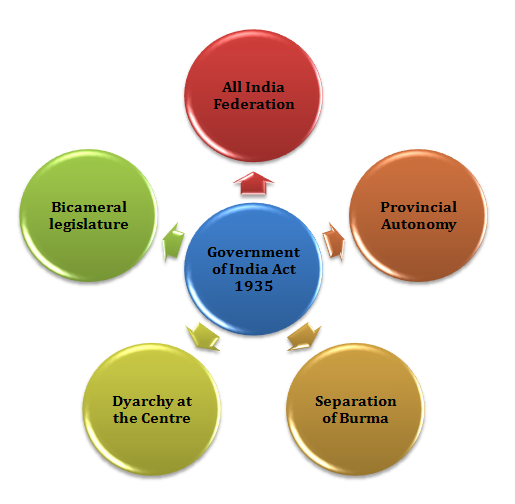

The Government of India Act of 1935 surrendered the Government of India's federal form. This act terminated the diarchy system that was introduced through the Act of 1919 and helped in the formation of an Indian Federation to be made up of British India Provinces and Princely states. The first time India introduced the direct election was by this act. This act split the Orissa and Bihar and Sindh from the Bombay Presidency.
The Government of India Act 1935 was passed by the British Parliament on 24th July 1935 and the act was put into action on 1st April 1937. This act was created based on the report of Lord Linlithgow’s Joint Select Committee.
That data was collected from the analysis of the Joint Committee of the British Government’s White Paper, a reformation programme of the constitution that was created after the Round Table conferences held in the middle of 1930-1932.
This Act of the British Parliament was expensive before the Greater London Authority Act of 1999. This Act and the Indian Constitute influenced the feature of administration.
The Government of India Act 1919 was short for self-government provisions form that is imposed in India and was not satisfactory. At that time the politicians of India thought that the part control officially was still under the authority of the British officials.
Therefore Simon Commission got an order to review that matter and made some changes to it. In the report of The Simon Commission, it was observed that the record was not satisfactory that led to a discussion with the representative of the Indian Community at the Round Table conference which was summoned in London.
The conference was not a success because the British were unable to complete the goal but in the year 1933, a White Paper was issued depending on the proposal of the conferences and the work on the constitution of India started. Lord Linlithgow was appointed as the chairman of a committee for considering the proposal of White Paper. The committee’s report was published in 1934 and passed as a bill in the British Parliament.
All India Federation − An All India Federation was established by the 1935 Act that consisted of the Princely states and the provinces of British India but it was not compulsory for the Indian states. This act stated that if about 50% of Indian states joined the federation then India would become a federation (Rodrigues, 2021).
Provincial Autonomy − A great feature of this act was the starting of the autonomy of provinces. Those provinces were permitted to operate as autonomous administration units in their spheres but in 1939 this act was discontinued.
Division of Subjects − The 1919 Act gave the division of subjects that was revised and some new subjects were added to it by the 1935 Act and three lists were included such as: 59 items in the Federal list, 54 items in the Provincial list and 36 items in Concurrent list.

Provisions of Government of India Act 1935
Diarchy at the Centre − The 1935 Act demolished the Provincial level diarchy and it was introduced at the Centre. The federal subject was categorised into two categories such as: Reserved Subjects and Transferred Subjects.
Bicameral legislature − The 1935 Act stated that the Central Legislature would be bicameral and consisted of the Council of States and the Federal Assembly. Bicameralism was executed in 6 out of the 11 provinces.
Federal Court − A federal court was built to resolute debate in provinces and in between the provinces and centre. It consisted of one Chief Justice and six judges.
Separation of Burma − The Simmon Commission suggested to the Indian Government to detach Burma and India and this was accepted in this act.
This 1935 Act gave the Governor General tremendous power that decreased the autonomy of the province to a farce. The suggestion of the creation of the Federation was defective fundamentally. Join the Federation was compulsory for the British provinces whereas it was voluntary for the Indian states.
This act failed to give an appropriate structure for the federal the maximum power was held by the Governor General. It was unable to retain the Communal Electorate system. The legislation could not able to give individuals flexibility with the constitution in terms of modifying their rights.
The Government of India Act 1935 came into action in 1937 by the British Parliament and it was the first try to hand over the autonomous status to the provinces. It was beneficial for women to get separate electorates that helped them in improvement in the procedure of decision-making. The British Parliament and the Secretary of State for India were the actual rulers of India until 1947 and as a result, it is expected that the 1935 Act faced hatred and resentment.
Q.1. What was the Government of India Act 1919?
Ans. The Government of India Act 1919 was issued by the British parliament to rises the Indian participants in the Indian administration. This act was created based on the report of Edwin Montagu and Lord Chelmsford.
Q.2. What was the significance of the Government of India Act 1935?
Ans. The significances of the Government of India Act 1919 were: women did not apply for separate electorates but the act gave it to woman, Article 315 of the Indian Constitution was taken from this act and this act gave the provinces autonomous status.
Q.3. Why did the Government of India Act 1919 fail?
Ans. The Government of India Act 1919 failed because this act protracted consolidated representation, the Governor General had the power to blunt the legislatures at the provinces and centre and the Rowlatt Acts restricted the press and any kind of movement.